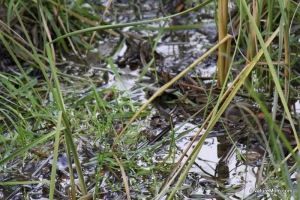
As I sit here at my computer with the backdoor open to allow some fresh air into our home, I’m listening to the lovely sound of frogsong. The chorus is coming from the creek on the other side of our backyard fence. Up until today, we’ve only been hearing one frog at a time. Suddenly, this afternoon,I can’t distinguish how many I hear. Has the mating season begun?
I have to confess, I’m crazy about frogs. I grew up in a house with a creek running through the backyard. I spent many, many hours wading in that creek, studying frogs in my childlike way. I observed frogs mating in the creek. I studied the long gooey strands filled with little black eggs . I watched eggs hatch. I noticed how one day the tadpoles would have legs. Then I observed that the after the tadpoles were gone, there would be tons of tiny baby frogs hopping around the backyard.
Today, as an adult, the chorus of frogsong makes me happy. However, even though I’ve been living in this home for ten years now, I am yet to see one of the frogs that lives in the creek behind our home. I’ve looked, but I can’t find them. I’ve heard from neighbors that the federally threatened California red-legged frog lives in the creek. I want to learn more.
So this year, I’ve signed up to participate in the citizen science project, FrogWatch USA. Volunteers in the program learn to identify the calls of frogs in their region and, as stated on the official website, “contribute to the FrogWatch USA’s base of scientific data by following scientific and standardized data collection protocols.”
And I can’t wait to share this activity with my son!
***
Interested in participating?
Here are the requirements and enrollment information…
- You must have an interest in frogs and toads. If you’ve read this far, I assume you do!
- Sign up to participate and enroll in a training session. In order to participate, a volunteer must attend a training session. Here in the San Francisco Bay Area, training is held at CuriOdyssey in San Mateo. Training for 2013 will be held on Saturday, February 23rd (see details and sign up here…http://www.curiodyssey.org/exhibits-and-animals/animal-care/citizen-science). If you live elsewhere in the United States, click here to find a training location near you… http://www.aza.org/become-a-frogwatch-volunteer/.
- Lastly, you must commit to monitoring a wetlands site for three minutes multiple evenings throughout the breeding season.
Let’s do what we can to help the frogs.. they need it!

We used to have tree frogs as pets… Cool!
LikeLike
Frogs make great pets!
LikeLike
I spent time watching (and holding) frogs in a nearby creek as a child a well. As a biologist, I have worked to protect the California red-legged frog and other threatened and endangered species around construction sites. Now that I have a child, this volunteer program sounds like a great activity to share with her when she gets older. Thank you for sharing and for volunteering!
LikeLike
Thank you and other biologists who help protect the endangered species from construction. The church up the hill is desperate to build a retirement home in the open space near our home as a revenue source, which would wipe out this creek. Not to mention, block the thoroughfare of other wildlife in the region (coyotes, deer, mountain lions, etc.)
LikeLike
Good for you! I love the sound of frogs. It’s grown far too infrequent of late.
LikeLike
Exactly. It’s sad how the frogs have disappeared.
LikeLike
It is sad. The bees, too. I’ve been following the Great Sunflower Project which is counting bees in 15 minute increments, too. I plan to join in this summer if it is still viable.
LikeLike
I joined The Great Sunflower Project last summer, but I failed at growing any flowers. The birds ate everything. Even all the flowers off our rosemary bushes.
LikeLike
I’m sorry you didn’t get any flowers last summer. I’m usually doing battle with the squirrels more than birds. It took several attempts to get the sunflowers growing. I finally devised a contraption made from screen to protect the seeds/seedlings till they were strong enough to withstand them. The birds pecked at the leaves all summer long, but not the seeds.
LikeLike
Now with spring coming many animal species are moving into mating season mode in the North of the world. Great to be so close to nature.
LikeLike
Even though we’re still in the heart of winter, there are days that feel like Spring. You can almost feel the transition that will soon occur. The creek behind our home is dry by May or June, so they have a short period of time to be active.
LikeLike